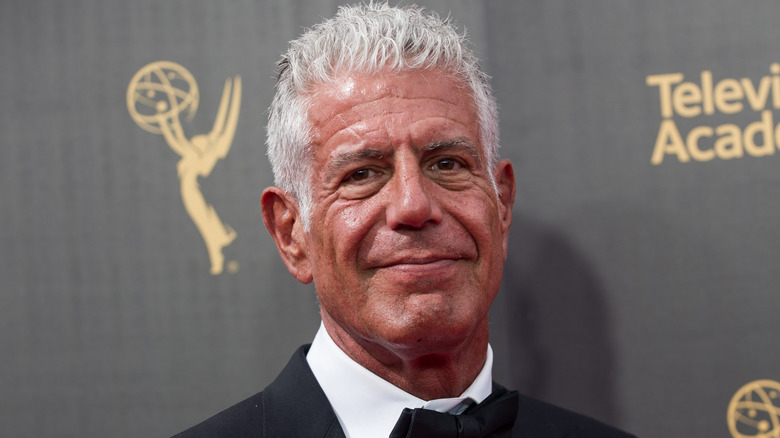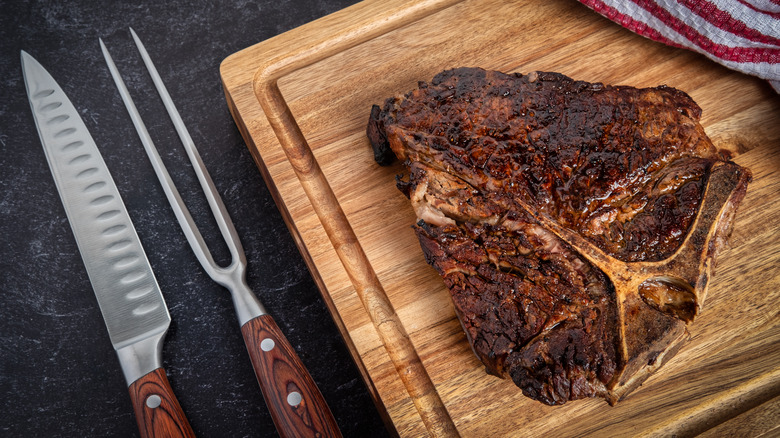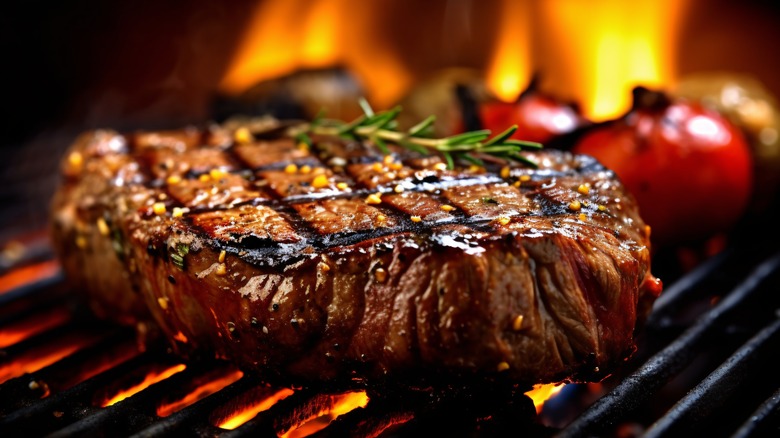The Most Crucial Step For Perfect Steak, According To Anthony Bourdain
There are all sorts of secrets to achieving a perfectly seared, succulent steak at home, from choosing the best cuts of steak to grill to cooking the right side of the meat first. But if you're not letting it rest after it cooks, then you're committing the ultimate carnivorous crime, according to Anthony Bourdain.
Resting meat after cooking it makes it significantly more juicy, tender, and enjoyable to eat. The extra few minutes sitting off the heat allows the muscle fibers to relax, so all the delicious juices within the protein can begin to redistribute throughout the steak. Essentially, those juices are reabsorbed into the beef, rather than pooling on the plate as they would if you sliced it immediately. It's so important that Bourdain described resting the meat as "the most overlooked feature" when it comes to "the success or failure of a steak" (via YouTube).
As for how long you should rest a steak after grilling, it's best to leave it for half the amount of time you originally cooked it. For Bourdain, this generally equated to around five to seven minutes of resting time. And the chef had plenty of other tips for steak, too — both in terms of how to cook it for the best results every time and exactly how you should rest it.
Leave steak alone as it rests for the best results
A steak will continue to cook as it rests — a process known as carryover cooking. It's why you should always remove the meat from the heat before it's cooked to your required doneness, as the temperature will continue to rise by a few degrees. So if you're after a medium rare steak with a final temperature of 130 degrees Fahrenheit, pull it off the grill or out of the pan when the internal temperature reads 125 degrees.
How a steak rests will determine how much it carries on cooking. Using a low oven may be a popular place to rest meat, but the carryover cooking means that you can end up with an overcooked steak. For Anthony Bourdain, the best practice is to leave the meat to rest on a cutting board, at room temperature. And most important of all during this period? "Don't touch it," Bourdain insisted (via YouTube). While it may be tempting to slice into it and have a peek, there are better ways to tell if a steak is properly cooked, such as using a digital meat thermometer.
Some home cooks like to wrap or cover a resting steak with aluminum foil to stop the meat cooling too quickly, but Bourdain warned against this, recommending the beef sit uncovered. However, if you do prefer to cover meat, the best advice is to make a loose tent out of the foil, which allows air to circulate.
More Anthony Bourdain tips for perfectly cooked steak
To avoid common mistakes while cooking steak, it's important to pick the right cut. For Anthony Bourdain, the tender yet expensive tenderloin was a "boring" option (via YouTube). Instead, he preferred rib steaks, which include entrecote and cote de boeuf (both a type of ribeye) because you get a great ratio of fattiness and lean meat. Fat, and especially marbling, adds flavor when it melts into steak during cooking, but it also makes it extra juicy and prevents it from drying out.
Another mistake the chef believed people make when grilling steak is to "rush the flame" and have the temperature too hot, he revealed in an interview with Men's Health. It's always best to take your time with steak for the best results. If you prefer, you can start it on the grill or in a skillet on the stovetop, and then put it in the oven to finish cooking. This method is how Bourdain liked to cook his steak au poivre.
The chef also loved plenty of salt on his steak, and he believed the timing of when to salt the meat was crucial. The perfect moment to add it, he advised, is right before the piece of beef hits the grill. This gives the meat a flavorsome and well-browned crust. Bourdain favored large grain sea salt, which is considered to be the best type of salt to season steak with thanks to its coarser texture.



